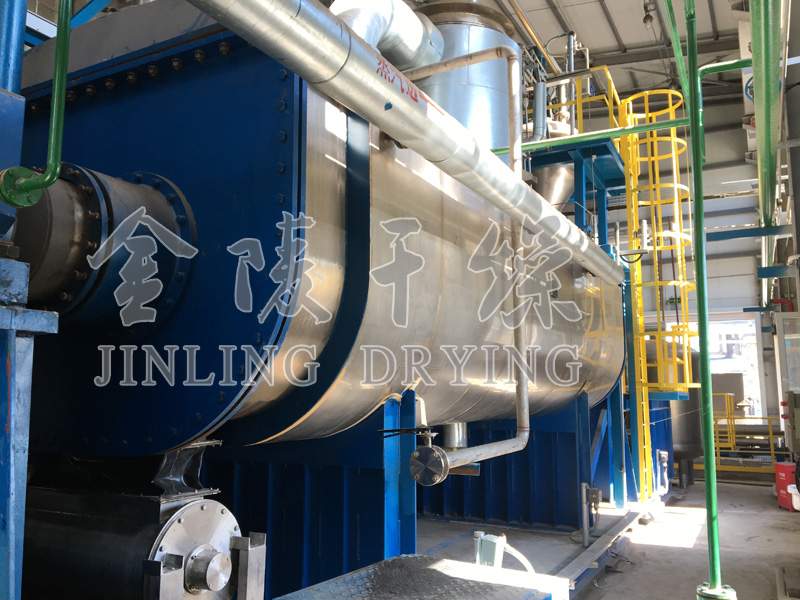Electroplating sludge refers to the precipitation produced in the process of electroplating wastewater treatment with heavy metal hydroxides such as copper and chromium as the main components, and the composition is complicated. Due to the large amount of electroplating wastewater, complex composition, high COD, and high heavy metal content, if it is discharged without treatment, it will cause serious environmental pollution. When treating electroplating wastewater, a large amount of electroplating sludge will be formed. These electroplating sludges have the characteristics of high water content, high thermal stability of heavy metal components, and easy migration. If not properly treated, it is easy to cause secondary pollution.
Describe:
Paddle dryer has low energy consumption. Due to indirect heating, there is no large amount of air to take away the heat. The outer wall of the dryer is provided with an insulation layer. For slurry materials, only 1.2kg of water vapor is needed to evaporate 1kg of water. The blade dryer system has a low cost and a huge heat transfer surface per unit effective volume, which shortens the processing time and reduces the equipment size. This greatly reduces the building area and building space. It has a wide range of processing materials and uses different heat media. It can process heat-sensitive materials as well as materials that require high-temperature processing. Commonly used media are: steam, heat transfer oil, hot water, cooling water, etc. It can be operated continuously or intermittently, and can be used in many fields. The dry environment of the blades is less polluted: no air is used, and there is little dust material entrainment. The solvent evaporation of the material is small, which is easy to handle. For contaminated materials or working conditions that require solvent recovery, a closed loop can be used. The operation cost is low and the operation is stable. Due to the special compression-expansion and stirring effect of the wedge-shaped blade, the material particles are fully in contact with the heat transfer surface. In the axial interval, the temperature, humidity, and mixing degree gradient of the material is very small, so Ensure the stability of the process.
Special point:
The dryer has low energy consumption and high thermal efficiency: due to indirect heating, there is no large amount of air to take away the heat, and the outer wall of the dryer is provided with an insulation layer, and the thermal efficiency is 70% to 80%.
The dryer system has a low cost: the unit effective volume has a huge heat transfer surface, which shortens the processing time and reduces the size of the equipment. This greatly reduces the building area and building space.
The dried product has uniform moisture and good quality. The residence time distribution of the materials in the dryer is narrow, the interface of the materials is updated at a high rate, heat and mass transfer are strengthened, and the products are dried evenly.
A wide range of processing materials: using different heat media, it can process heat-sensitive materials and materials that require high-temperature processing. Commonly used media are: steam, heat transfer oil, hot water, cooling water, etc. It can be operated continuously or intermittently, and can be used in many fields.
Environmental pollution is small: no air is used, dust materials are rarely entrained. The solvent evaporation of the material is small, which is easy to handle. For contaminated materials or working conditions that require solvent recovery, a closed loop can be used.
Low operating cost: The equipment operates normally, only 1 hour/day·person. Low speed mixing and reasonable structure. The amount of wear is small and the maintenance cost is very low.
Stable operation: Due to the special compression-expansion and stirring effect of the wedge-shaped blades, the material particles are fully in contact with the heat transfer surface. In the axial interval, the temperature, humidity, and mixing degree gradient of the material are small, thereby ensuring the process stability.
The drying process uses less air, has a low flow rate, and less dust carried away by the gas: Therefore, the gas dust after drying is convenient to recover, and the recovery equipment is simple, saving equipment investment. For the drying process with solvent recovery, the concentration of the solvent in the gas can be increased to reduce the solvent recovery equipment or shorten the process.
Due to the special structure of the blade, the material is alternately squeezed and relaxed during the drying process, which strengthens the drying. In addition, when the two blades rotate in opposite directions, they have a self-cleaning effect, so it can also be applied to viscous and pasty materials.
